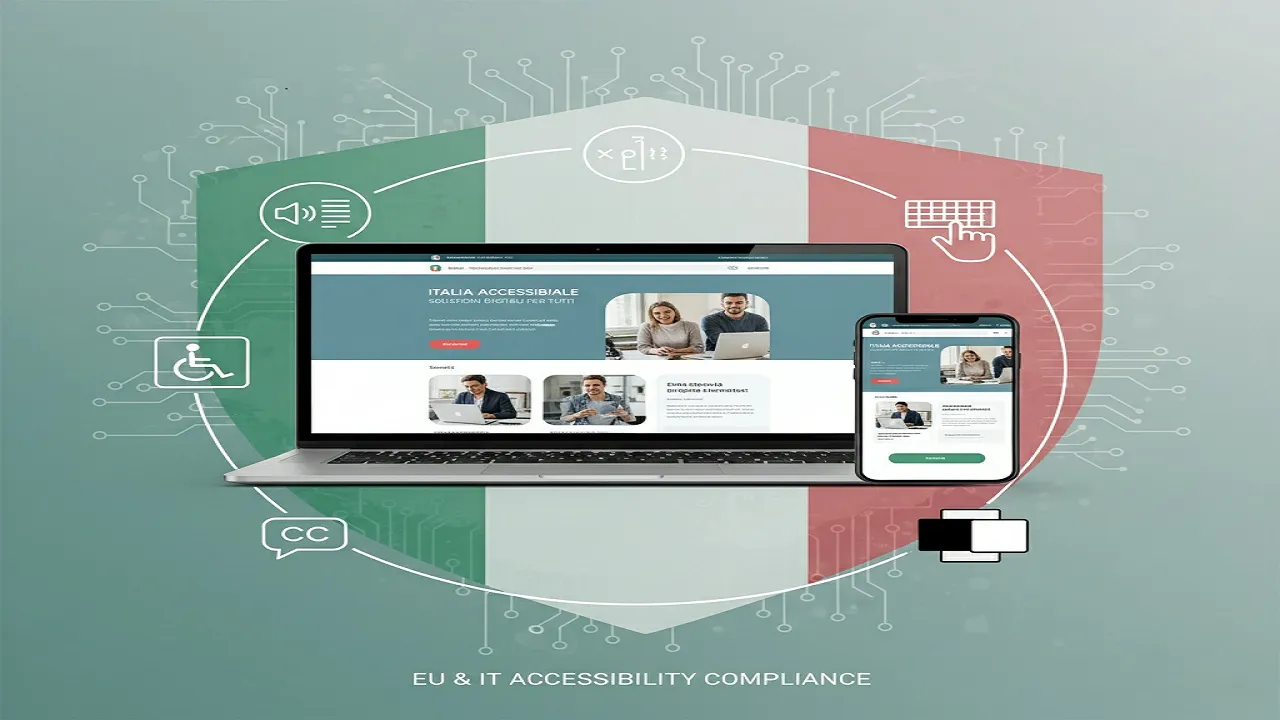Website accessibility is not just a trend — it’s a necessity. For businesses in Italy, making your site accessible is a way to reach more users, improve SEO, and stay ahead in a regulated digital environment. In this article, we will explain the what, why, and how of website accessibility, especially in the Italian/EU context, and show you actionable steps to build a more inclusive web presence.
What Exactly Is Website Accessibility?
Accessible website design ensures that people with disabilities—visual, hearing, cognitive, or motor—can use your site effectively. Here are the essentials:
- Use alt text for images so screen readers can describe them
- Offer captions/transcripts for audio and video
- Ensure keyboard navigation (no mouse requirement)
- Maintain sufficient contrast between text and background
- Use semantic HTML (proper headings, ARIA labels)
- Provide skip links (“skip to content”) for better navigation
These practices align with the Web Content Accessibility Guidelines (WCAG) and benefit all users — not just those with disabilities.
Why Website Accessibility Boosts SEO & Usability
Many top-ranking pages about accessible website design stress the overlap between accessibility and SEO. accessiBe+1
Here’s why:
- Better crawlability & structure: Semantic headings, alt text, and clear navigation help search engines understand your pages.
- Lower bounce & higher engagement: Users who can easily access and read your site stay longer
- More keywords & traffic: Some studies report sites with better accessibility also rank for more keywords accessiBe
- Inclusive reach: You open your brand to people with disabilities, elderly users, or those using assistive tech
In short: accessible site = user-friendly site = SEO win.
Legal & Regulatory Context in Italy & EU
Understanding the legal side is vital for Italian businesses.
Italy & the EU: What You Must Know
- Public sector websites in Italy must follow the EU Web Accessibility Directive and meet WCAG AA standards. allaccessible.org+2equalweb.com+2
- Italy implements this via national laws (e.g., the “Legge Stanca”) and mandates the publication of an accessibility statement for public websites. Recite Me+2equalweb.com+2
- The main technical standard is EN-301549, which aligns with WCAG guidelines. equalweb.com
- While the rules directly bind public bodies, private businesses may also be affected (for example, when contracting with the government or under anti-discrimination law). equalweb.com+1
- The European Accessibility Act (EAA), coming into force soon, extends requirements to many digital goods and services in the EU, including some in commerce. DemoUp Cliplister+2Recite Me+2
So, even private firms in Italy should take accessible website design seriously — it’s no longer optional.
Steps to Create an Accessible Website in Italy
Here’s a roadmap you can follow:
1. Perform an Accessibility Audit
- Use automated tools (e.g., WAVE, Lighthouse, Axe) DemoUp Cliplister+2Brafton+2
- Complement with manual testing (keyboard only, screen readers)
- Review your accessibility statement to ensure transparency
2. Fix the Basics
- Add alt attributes to all meaningful images
- Add video captions & audio transcripts
- Ensure contrast ratio meets WCAG (e.g., 4.5:1 for normal text)
- Make all interactive controls accessible via keyboard
- Use ARIA labels appropriately (buttons, form fields)
- Avoid using images that convey meaning without text fallback
3. Improve Navigation & User Flow
- Include “skip to content” links
- Use a consistent navigation layout across pages
- Use proper heading hierarchy (H1 → H2 → H3)
- Offer search, filters, and breadcrumb trails
4. Test with Real Users
- Invite people with visual, motor, or cognitive impairments to test
- Observe where they struggle
- Iterate based on feedback
5. Maintain & Monitor
- Schedule regular audits (quarterly or semiannual)
- Keep accessibility in updates and redesigns
- Monitor new content (e.g., images, media) for compliance
- Stay updated on WCAG versions and EU law changes
Overcoming Common Challenges
- Large legacy sites: Apply fixes page by page, prioritize high-traffic areas
- Media & dynamic content: Use captioning, transcripts, and proper ARIA roles
- Third-party plugins or embeds: Choose accessible plugins or wrap with accessible containers
- Language & localization: Provide proper lang attributes (for Italian “it”)
- Budget constraints: Start with small fixes; even low-cost changes yield benefits
Benefits Beyond Compliance
- Brand goodwill and trust: showing inclusivity
- Wider market access: reaching users with disabilities
- Better user experience for all: clarity, structure, readability
- Reduced risk of legal claims, especially for public contracts
- SEO uplift: more traffic, more pages indexed
Conclusion
In Italy’s evolving digital landscape, website accessibility is no longer an optional feature — it’s essential. By investing in accessible website design, you open your brand to more users, improve SEO performance, and ensure compliance with EU and Italian norms. Begin now with an audit, fix the obvious issues, test with users, and make accessibility part of your ongoing strategy. When you treat website accessibility as a priority, your site becomes stronger, safer, and more inclusive.
FAQs
- What is the minimum standard for accessibility?
The current minimum target is WCAG 2.1 Level AA, which most EU directives and legal regimes adopt. - Do private businesses in Italy have to comply with these regulations?
Directly, the law focuses on public bodies. But private firms may be required when working with the government or under anti-discrimination laws. - What tools can I use to test accessibility?
Popular tools include WAVE, Lighthouse, Axe, and manual screen reader testing. - How long does it take to make a site accessible?
It depends on the site’s size and complexity — a small site might take weeks; a large one months. - Will accessibility hurt my design or branding?
Not if done thoughtfully. You can maintain brand identity while ensuring contrast, readability, and usability. - Does accessibility improve SEO?
Yes — accessibility measures (like alt text, structure, readability) often align with SEO best practices. - What is an accessibility statement?
A public declaration (often required for public bodies) that describes your site’s accessibility status, known limitations, and contact information for feedback.

